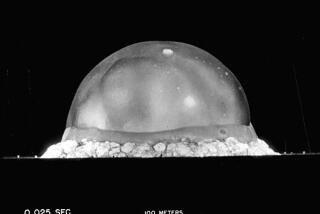A Credo for Science ’04
- Share via
Science is generally understood as a slow but steady ascension, an effort to develop certitude about things thus far beyond our ken. In 2004, scientists made plenty of progress, but nature kept raising the bar, showing how much is still left to learn. This hit home with brutal clarity after Sunday’s deadly tsunami in South Asia; triggered by movement in a fault thought to be relatively inactive, the disaster was a reminder that geologists have barely begun to fathom the tensions that animate tectonic plates.
Despite such failures, there were many achievements. One of the biggest was announced Dec. 6 by scientists in New York, who developed a way for paralyzed people to control a computer cursor simply by thinking about it, by using the faint electricity that naturally radiates from every brain.
In engineering, scientists in Livermore, Calif., hired by the Department of Homeland Security to develop ways to detect radiation from “dirty” bombs, first despaired over finding a technology that could do the job economically. Then they realized that common cellphones already scan for radiation. The lab is now designing phones it hopes to distribute to thousands of law enforcement officers; they will automatically scan for caches and report their location, pinpointed with a global positioning satellite receiver, to Homeland Security computers.
In space exploration, NASA’s two Mars rover missions demonstrated persuasively that the Red Planet was once warm, wet and salty -- just the “candidate environment” for early life that astronomers had been looking for. And in physics and chemistry, scientists tinkered with ultracold gases known as condensates to induce a set of atoms to behave as a single “super atom” -- work that could help explain what happens when materials become superconductors, allowing electricity to flow through them with no resistance and, hence, no loss of power.
The more humbling lessons of 2004 came when scientists found themselves stumped by challenges they thought they had mastered. Biologists, for example, began to see that the 90% of human DNA that they had dismissed as “junk” may in fact contain the chemical codes that direct the activity of the other 10% -- the hallowed “protein-coding regions,” which build the body’s tissues.
Epidemiologists funded by Homeland Security to look for stashes of bioweapons abroad instead discovered that naturally occurring viruses such as avian influenza could prove far more deadly than any man-made weapons. This month, the disease researchers warned that outbreaks of a strain of bird flu had pushed the world closer to a pandemic that could kill up to 7 million people and infect 30% of the global population.
Finally, a team of scientists from New York’s Cornell University showed that the century-old standard chemical model of the structure of water -- water! -- may be wrong.
In “On the Move,” Thom Gunn, a California poet who died in 2004, wrote that though “birds and saints [may] complete their purposes,” man will always be striving. “At worst, one is in motion; and at best / Reaching no absolute, in which to rest, / One is always nearer by not keeping still.”
Gunn’s poem may strike some as more theological than scientific: a celebration of human limits rather than an avowal to rise above them. But it could be a good credo for the scientists of 2004, who may not have learned everything they wanted but grew closer to understanding by not keeping still.






